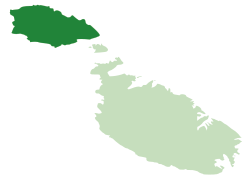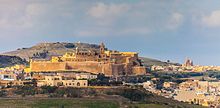| The Gozitan NationLa Nazione Gozitana (Italian) In-Nazzjon Għawdxi (Maltese) | |||||||||
|---|---|---|---|---|---|---|---|---|---|
| 1798–1801 | |||||||||
 Flag
Flag | |||||||||
 Location of Gozo within the Maltese Islands Location of Gozo within the Maltese Islands | |||||||||
| Status | Unrecognised state De facto independent state | ||||||||
| Capital | Rabat | ||||||||
| Common languages | |||||||||
| Religion | Roman Catholicism | ||||||||
| Government | Provisional feudal monarchy | ||||||||
| King | |||||||||
| • 1798–1801 | Ferdinand III of Sicily | ||||||||
| Governor-General | |||||||||
| • 1798–1801 | Saverio Cassar | ||||||||
| Historical era | French Revolutionary Wars | ||||||||
| • Revolt | 3 September 1798 | ||||||||
| • Established | 28/29 October 1798 | ||||||||
| • British protectorate established | 4 September 1800 | ||||||||
| • Disestablished | 20 August 1801 | ||||||||
| Currency | Maltese scudo | ||||||||
| |||||||||
| Today part of | Malta | ||||||||
The Gozitan Nation, commonly known as Gozo, was an unrecognised state located on the island of Gozo between 1798 and 1801 during the French Revolutionary Wars. It was a monarchy recognizing the authority of Ferdinand III of Sicily with a provisional government led by Governor-General Saverio Cassar. Its capital was Rabat. The country was established between 28 and 29 October 1798 from the territory of French-occupied Malta and was eventually incorporated into Malta Protectorate on 20 August 1801.
History

Until 10 June 1798, Malta and Gozo had been administered by the Knights Hospitaller. When Napoleon ousted the Knights from the islands in the Mediterranean campaign of 1798, the French established garrisons in various locations in Malta, as well as the Cittadella and Fort Chambray, the main fortifications on Gozo.
On 2 September 1798, the Maltese rebelled against the French in Mdina, requesting to return to rule by the Kingdom of Sicily. Word spread, and the Gozitans revolted on 3 September. The archpriest and parish priest of Rabat, Saverio Cassar, was chosen as the revolt's leader on 18 September. The rebel headquarters was established in the Banca Giuratale (which is now the seat of the Victoria Local Council). Cassar organized the dejma and collected money to pay the troops under his command. Pro-French partisans were arrested, including three canons.
The French garrison held out in the Cittadella and Fort Chambray until they capitulated on 28 October after negotiations made with the help of Alexander Ball. The 217 French soldiers there agreed to surrender without a fight and transferred the island, its fortifications, 24 cannons, a large quantity of ammunition, and 3200 sacks of flour to the British.

A day later, the British transferred control of the Cittadella and the rest of the island to the Gozitans. The people declared King Ferdinand as their monarch and established a provisional government led by Saverio Cassar, who became governor-general. The provisional government included several British and Maltese representatives, and their first action was to distribute the captured food supplies to the island's 16,000 inhabitants. The Neapolitan flag (which later became the flag of the Two Sicilies) was flown over Gozo, and munitions and supplies arrived from Naples, with King Ferdinand praising his "faithful Maltese subjects."
On 29 October, Cassar requested that Gozo become a separate diocese. The Roman Catholic Diocese of Gozo was eventually created on 22 September 1864, 65 years after Cassar's petition. During Cassar's rule of Gozo, he organized the administration, reopened the law courts and elected new jurists; and even opened a customs house.
King Ferdinand took advantage of Napoleon's absence in the French campaign in Egypt and Syria and of Horatio Nelson's victories and seized Rome on 29 November. On the defeat of some of his columns, Ferdinand hurried back to Naples. On the approach of the French, Ferdinand fled on December 23 aboard Nelson's ship HMS Vanguard to Palermo, leaving his capital in a state of anarchy. The French took Naples and the Parthenopean Republic was established by its citizens; Ferdinand reconquered it in May of 1800.
When the French garrison in Valletta surrendered in September of that same year, the British established the Malta Protectorate. Cassar continued to rule Gozo independently until 20 August 1801, when the British civil commissioner, Charles Cameron, removed him from the position. Emmanuel Vitale, another leader of the Maltese insurrection, became governor, superintendent and the health director of Gozo, a post which he held until his death fourteen months later.
On December 16, 1805, Cassar died at the age of 58.
Notes
References
- Vella, George (5 July 2005). "Outline History of the Circolo Gozitano". Circolo Gozitano. Archived from the original on 2 November 2014. Retrieved 2 November 2014.
- James, William. The Naval History of Great Britain, Volume 2, 1797–1799. Conway Maritime Press, 2002 , p 189. ISBN 0851779069
- Cahoon, Ben. "Malta". World Statesmen. Retrieved 2 November 2014.
- Sciberras, Sandro. "Maltese History - F. The French Occupation" (PDF). St Benedict College. Archived from the original (PDF) on 3 May 2015. Retrieved 2 November 2014.
- Castillo, Dennis Angelo (2006). The Maltese Cross: A Strategic History of Malta. Westport: Greenwood Publishing Group. p. 120. ISBN 9780313323294.
- "Historical Note". Gozo Diocese. Retrieved 2 November 2014.
- Davis, John (2006). Naples and Napoleon: Southern Italy and the European Revolutions, 1780-1860. Oxford University Press. ISBN 9780198207559.
- Schiavone, Michael J. (2009). Dictionary of Maltese Biographies A-F. Malta: Publikazzjonijiet Indipendenza. pp. 533–534. ISBN 9789993291329.
| Background | |||||||
|---|---|---|---|---|---|---|---|
| Occupation | |||||||
| Siege of Malta | |||||||
| Fortifications | |||||||
| Notable figures |
| ||||||
| Aftermath | |||||||
| Client states of the French Revolutionary and Napoleonic Wars (1792–1815) | |||||||||||||
|---|---|---|---|---|---|---|---|---|---|---|---|---|---|
| Sister republics |
|  Europe at the height of Napoleon's Empire Europe at the height of Napoleon's Empire | |||||||||||
| Napoleonic creations |
| ||||||||||||
| Malta articles | |||||
|---|---|---|---|---|---|
| History |  | ||||
| Geography | |||||
| Politics | |||||
| Economy | |||||
| Society |
| ||||
36°02′36″N 14°14′49″E / 36.04333°N 14.24694°E / 36.04333; 14.24694
Categories:- Gozo
- Client states of the Napoleonic Wars
- Island countries
- Former unrecognized countries
- French occupation of Malta
- 1798 establishments in Malta
- 1801 disestablishments in Malta
- States and territories established in 1798
- States and territories disestablished in 1801
- Former monarchies
- Ferdinand I of the Two Sicilies